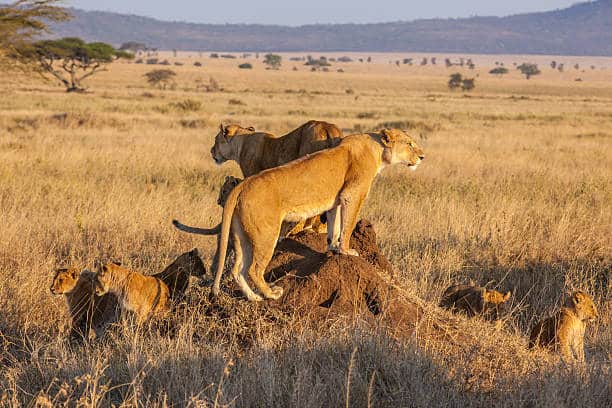
The African Lion
Lion / Big 5 Wildlife
Kingdom: Animalia
Phylum: Chordata
Class: Mammalia
Order: Carnivora
Family: Felidae
Genus and Species: Panthera leo
Name
The African lion (Panthera leo) is commonly referred to as the “king of the jungle,” though lions actually live on savannas and grasslands, not jungles.
Appearance
African lions are the second-largest big cats in the world, after tigers. They have powerful bodies with well-developed muscles, particularly in their shoulders and legs.
Males are easily recognisable by their large, flowing mane, which ranges in colour from light blond to dark brown or even black. The mane is a sign of masculinity and testosterone levels. The length and colour of a lion’s mane is often determined by age, genetics and hormones.
Females (lionesses) are smaller than males and lack manes. Both males and females have a tawny coat that provides excellent camouflage in their natural habitat. Lion cubs are born with spots that fade as they mature.
A lion's mane is a sign of masculinity and testosterone levels. The length and colour of a lion's mane is often determined by age, genetics and hormones.
Size
- Male lions:
- Length: 1.8 – 2.1 meters (6 – 7 ft) from head to tail, not including the tail
- Weight: 190 – 250 kilograms (420 – 550 lbs)
- Height at the shoulder: up to 1.2 meters (4 ft)
- Female lions (lionesses):
- Length: 1.4 – 1.8 meters (4.6 – 5.9 ft) from head to tail, not including the tail
- Weight: 120 – 180 kilograms (260 – 400 lbs)
- Height at the shoulder: up to 1.1 meters (3.6 ft)
Diet
African lions are apex predators, meaning they sit at the top of the food chain. They are obligate carnivores, meaning their diet consists solely of meat. Their primary prey includes large herbivores such as zebras, wildebeest, antelope, and buffalos.
Lionesses are the pride’s primary hunters, working together to stalk, chase, and take down prey. Lions are powerful hunters, but they are also scavengers and will sometimes steal kills from other predators like hyenas. In fact, contrary to popular belief, lions steal more kills from hyenas than hyenas steal from lions. It is more common for hyenas and other scavengers, like jackals and vultures, to scavenge from a kill once the lions have had their full and have already left the carcass.
Once a lion has eaten a large meal, you’ll find them lying under a tree or lounging in the shade not too far from the kill site, where they’ll sleep and rest for the next 20 to 30 hours before needing to hunt again. So, the bigger the prey, the bigger the meal and the longer the lions can rest for in between hunts.
Location and Habitat
Once widespread across most of Africa, the African lion’s habitat has shrunk significantly. Today, they are primarily found in sub-Saharan Africa, inhabiting savannas, grasslands, and open woodlands. These environments offer good visibility for hunting and open spaces for stalking prey.
The Behaviour of Lions
Holding the title of Africa’s top predator is tiring work. Lions spend up to 21 hours a day sleeping and resting. But it’s all for good reason. Did you know that lion’s only have a few sweat glands? So, in order to conserve energy, they spend the majority of the day resting and lazing around in the shade and become more active at night, when it’s cooler. They also have incredible night vision and are 6 times more sensitive to light than humans.
Life in the Pride
Lions are the most social big cats, living in groups called prides. A pride typically consists of several related females, their cubs, and one or two males. The females in a pride are responsible for most of the hunting, while the males defend the pride’s territory from other lions. Lion prides have a complex social hierarchy, with the dominant male having priority access to food and mates.

Hunting in a Pride
Living in a pride gives lions an incredible advantage in the wild. Larger social groups provide better protection and defence against threats, better food, and better survival rates for all. As the primary hunters, lionesses thrive within the social structure of prides. Working together, they are able to target larger prey, look after more young, and even fend off competing prides, hyenas, and rogue males which pose a threat to their cubs.
If you ever have the opportunity to witness lionesses hunting, you’ll soon appreciate why lions are so successful. Lionesses will strategically position themselves around their target. Surrounding their prey, they will camouflage themselves in the grass while one lioness stampedes or charges at the herd to ‘scatter’ the animals, making it easier to separate young calves and isolate weak or injured prey. The other lionesses will lie in wait, ready to pounce and grapple with the fleeing animals.
Lions are proficient hunters and leverage their team work to take down large prey. They target the throat, nasal passage or jugular, suffocating their prey. Other lionesses will also jump on the prey’s back or hind, and even claw at the stomach or hind legs, targeting key muscles, organs and the spinal cord. This effectively immobilises the animal, preventing its escape.
Territory
Lions are territorial animals. The size of a pride’s territory can vary depending on factors like prey availability, but it can range from 20 to 1,500 square kilometres. Males with a pride will vigorously defend their territory from other males. In fact, keeping their territory safe from threats and roaming males is a full time job. While the lionesses are out hunting, the males are out patrolling and marking their territory.
From the time they mature, males lions compete, often to the death, for their own territory and pride. Male cubs are expelled from the pride at about three years of age and become nomads until they are old enough to try to take over another pride.
However, many adult males remain nomads for life. Mating opportunities for nomad African lions are rare, and competition between males to defend their pride’s territory and mate with the pride females is fierce — often resulting in serious injury, death, and even fights within the pride as the new male must also seek acceptance with the lionesses.
Breeding
Lionesses reach sexual maturity around 3 to 4 years old, while males take a bit longer to mature and can take up to 4 or 5 years.
Females are polyestrous, meaning they can come into heat several times a year. Within the social hierarchy of a pride, this is important as cubs suffer a high mortality rate.
Cubs are able to follow their mothers at about three months of age and are weaned by six or seven months. They begin participating in kills by 11 months but probably cannot survive on their own until they are two years old. Although lionesses will nurse cubs other than their own, they are surprisingly inattentive mothers and often leave their cubs alone for up to 24 hours.
Lion cubs are born blind and helpless, and they rely on their mother for milk and protection. Cubs typically stay with the pride for several years until they are old enough to become independent.
What is the Biggest Threat to Lions?
Three hundred years ago, the biggest threat would have been buffalo or hyenas. Today, the greatest danger to African Lions comes from humans. Canned hunting, urban expansion, trophy hunting, and the illegal trade of lion bones and lion pelts has pushed these majestic creatures to the brink of extinction.
African lions are classified as vulnerable by the IUCN Red List. The biggest threats to their survival include habitat loss due to human encroachment, conflicts with humans over livestock, and poaching. Conservation efforts, like ARC’s Lion Rescue Project, are important foundations created to protect lions in the wild and conserve their natural habitats.
Facts about the African Lion
Estimates suggest fewer than 20,000 African lions remain in the wild.
Lions are the only cats that live in groups, called prides. Living in large groups (prides) allows lions to hunt bigger prey, including buffalo, giraffe, zebra, Kudu, and even elephants.
Prides are family units that may comprise of anywhere from 2 to 40 lions. Although most prides consist of one male and a few females, it is common for prides to have up to three or four males, ten to twelve or so females, and their young.
Usually, only one or two males will be present in a pride at a time. These are usually related brothers who have taken over the pride together. They will drive out any other males to prevent them from mating with the females.
Lions are known for their roar, which can be heard from up to five miles away. Lions also communicate with a variety of other vocalizations, including growls, grunts, and purrs.
A lion’s roar can reach up to 114 decibels, which is about as loud as a motorcycle or a jet plane taking off at a distance.
When on safari, be sure to listen out for lions calling at night. A lion’s roar can be heard from up to 10 kilometres (five miles) away, and is a favourite experience for guests to hear amidst the sounds of the bush at night.
While lionesses do most of the hunting, males will also participate, especially when taking down larger prey. Their role is to overpower the prey, allowing the lionesses to deliver the killing bite.
Lions are incredible sprinters and can reach maximum speeds of up to 80 kilometres per hour (50 mph) in short bursts.
Lions are most active at dawn and dusk, when temperatures are cooler.
Baby lions called cubs.

